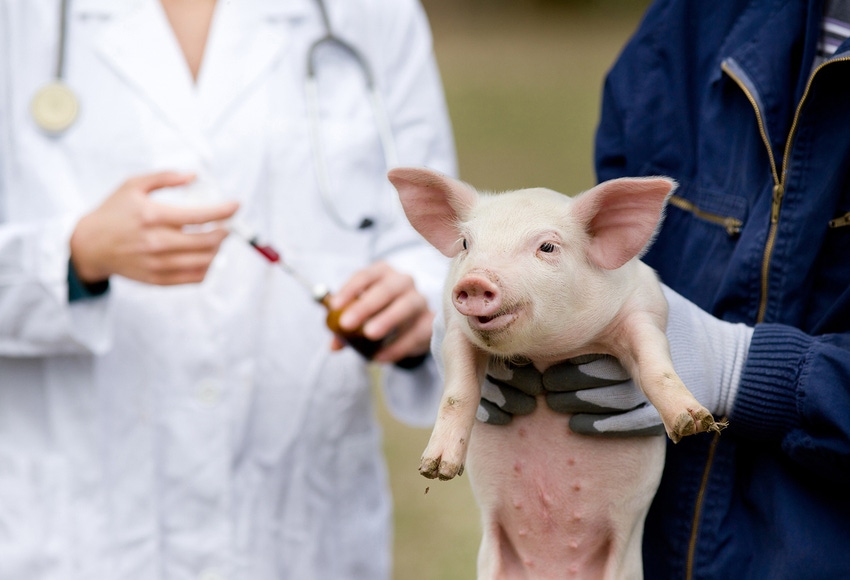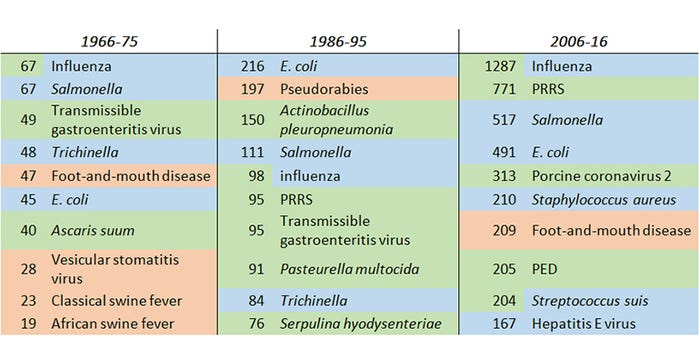Worldwide, pathogens in swine that have received the most research attention include Salmonella, Escherichia coli, influenza, pseudorabies virus and foot-and-mouth disease virus.
January 9, 2018

By Kimberly VanderWaal, PhD, University of Minnesota Department of Veterinary Population Medicine, and John Deen, DVM, PhD, University of Minnesota College of Veterinary Medicine
Despite the importance of infectious diseases to swine health, few efforts have been made to describe trends in infectious diseases of swine at the global scale. Publication trends on swine pathogens can be used as an indicator of research priorities in different regions and may reflect tendencies to focus research efforts toward endemic or foreign pathogens with higher prevalence, health consequences or economic impact. Through searching the scientific literature for publications on 40 swine pathogens, abstracts from over 57,000 publications from 1966-2016 were downloaded and assembled into a database.
Worldwide, pathogens in swine that have received the most research attention include Salmonella, Escherichia coli, influenza, pseudorabies virus and foot-and-mouth disease virus. Certain pathogens, such as influenza and porcine epidemic diarrhea virus, have publication rates that have increased quickly in recent years, reflecting the emerging global challenge of these pathogens. Publication rates for other pathogens, such as pseudorabies and Actinobacillus pleuropneumonia, have slowed, likely reflecting the diminished importance of this disease to global swine production as compared to other pathogens.
Each pathogen could be classified into one of three categories: Reportable diseases — pathogens listed as notifiable disease by the World Organization for Animal Health; Production diseases — not reportable, but have negative impacts on mortality, morbidity, reproduction, growth, etc.; and Zoonotic diseases — research interest is primarily motivated by impacts to human public health. Based on publication counts, the highest ranked reportable diseases globally were pseudorabies, FMD and classical swine fever. For production diseases, the list was topped by influenza, porcine reproductive and respiratory syndrome virus and APP. Notably, the top three pathogens overall (Salmonella, E. coli and influenza) were zoonotic.
Based on over 11,000 publications from the United States and Canada, the top 10 most published pathogens of swine have shifted over the past 50 years (Table 1). In recent decades, reportable diseases have appeared in the top 10 more rarely than 50 years ago (orange in Table 1). Their fall in rank may reflect shifting research priorities. For example, in the 1960s and 1970s, only three of the top 10 pathogens were associated with production. This number increased to six by the late-1980s and 1990s (green in Table 1). This greater prominence of production diseases in the swine literature may be related to growing intensification of swine production over this period.

Table 1: Top 10 pathogens by publication count in the United States and Canada across 50 years. Colors indicate zoonotic pathogens (blue), diseases affecting production (green) and reportable diseases (orange). Pathogens with two colors could be classified into two categories. The number of publications found for each pathogen that were swine-related are shown next to each name.
In the most recent 10 years, swine infectious agents that also have public health implications have drastically increased in rank (blue in Table 1), probably due to an overall shift in global research priorities and funding toward public health.
As compared to the United States and Canada, Europe (particularly western and northern Europe) publications tend to center more on pathogens related to zoonotic and food-borne concerns, reflecting policy differences and priorities in Europe (see map in Figure 1). Differences are also apparent between developed and developing (more tropical) regions. Helminth parasites, such as Taenia solium (pork tapeworm) and Toxoplasma gondii, appear far more frequently in the top five pathogens in developing regions. This may reflect differences in common disease challenges found in developing regions compared to more-intensified production common in developed countries.

Figure 1: Most important pathogens of swine by region during 2006-16, ranked by number of publications. Influenza appeared on each region’s list and thus was excluded from regional lists.
Trends over time and across regions should not be interpreted as reflecting the occurrence of disease. For example, research on foreign animal disease preparedness often is prioritized in countries that are free of the disease. However, assessing publication trends can be used as an indicator of the prioritization of a given pathogen, and provide insights on global research trends in swine infectious diseases.
You May Also Like


